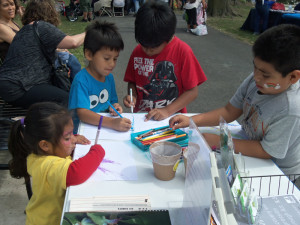Frog Photography and Frog Art from Around the World
The 14 judges are currently reviewing the entries submitted for the 2014 contests. There are so many incredible entries from across Jersey City, New Jersey, the United States and 32 countries around the world. The winners will be announced in January, 2015.
Here is the collected data for the 2014 Frogs Are Green Kids Art Contest: 973 Entries
32 Countries entered the 2014 Frogs Are Green Kids Art Contest
Australia, Bahrain, Bangladesh, Bulgaria, Canada, China, Croatia, England, Greece, Hungary, India, Indonesia, Iran, Ireland, Japan, Latvia, Malaysia, Morocco, Philippines, Romania, Russian Federation, Slovakia, Slovenia, South Africa, South Korea, Sri Lanka, Taiwan, Thailand, Turkey, Ukraine, United Arab Emirate, and USA.
17 States from across the USA entered the 2014 Frogs Are Green Kids Art Contest
Arizona, California, Florida, Georgia, Hawaii, Maryland, Michigan, New Jersey, New Mexico, New York, North Carolina, Ohio, Pennsylvania, South Carolina, Tennessee, Texas, and Wisconsin.
5 Cities in New Jersey entered the 2014 Frogs Are Green Kids Art Contest
Hoboken, Jersey City, Montclair, Piscataway, and South Brunswick.
16 Schools in Jersey City and Hoboken entered the 2014 Frogs Are Green Kids Art Contest
McNair Academic High School, PS #5, PS #23, MS #4, PS #3, PS #33, PS #28, MS #38, Golden Door Charter School, PS #25, PS #21, MS #7, Liberty High School, PS #31, Hoboken Catholic Academy, and the Hoboken Charter School.
Here is the collected data for the 2014 Frogs Are Green Photography Contests:
16 Countries entered the two 2014 Photography contests “Backyard Frogs” (34 entries) and “Frogs in the Wild” (56 entries)
Australia (NSW), Belize, Brazil, Costa Rica, Croatia, Denmark, England, Germany, India, Indonesia, Jamaica, New Zealand, Poland, Romania, Sri Lanka, and USA.
9 States in the USA entered the 2014 Frogs Are Green photography contests: “Backyard Frogs” and “Frogs in the Wild”
Arizona, Florida, Massachusetts, Minnesota, Nebraska, New Jersey, New York, North Carolina and Pennsylvania.
Below are the links to the 3 Flickr galleries, if you would like to see the imagery.
2014 Frogs Are Green Kids Art Contest
2014 Backyard Frogs Photo Contest
2014 Frogs in the Wild Contest
Thank you so much for your participation and good luck to all who entered! We would love to hear from the teachers and students! Tell us what you learned about frogs and amphibians! Tell us about the art mediums and techniques you used. If you’d like to post a video to the Frogs Are Green Facebook wall, we’d love to hear from you!
– Susan Newman, founder, Frogs Are Green, Inc. – A New Jersey nonprofit organization


